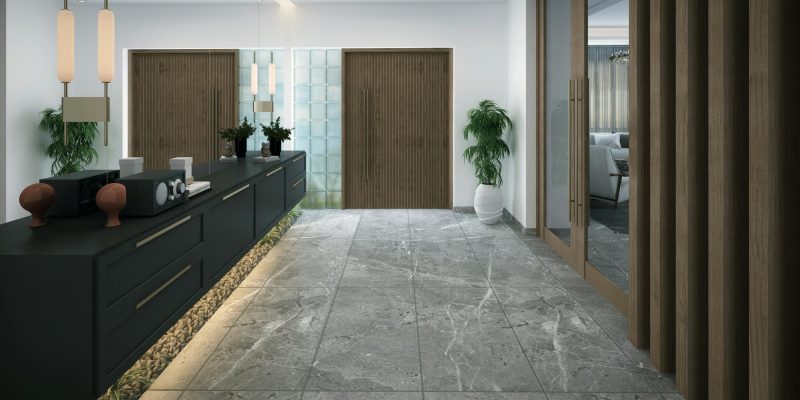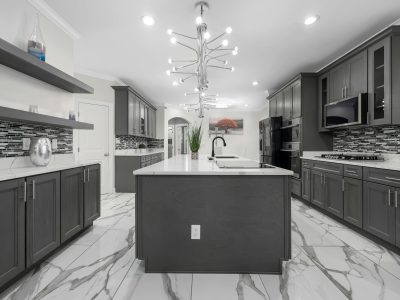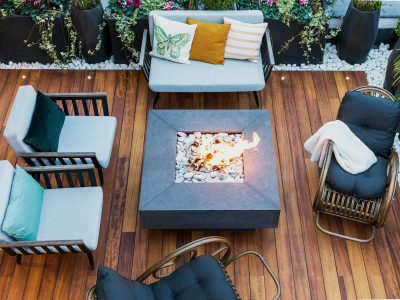Concrete floors are no longer just a low-maintenance and durable surface; now, they are also a beautiful foundation for modern interiors. Their versatility, strength, and variety of finishes enable them to complement homes, offices, and commercial spaces. Concrete flooring can be polished, stained, or textured?to create a fantastic look with endless design possibilities. We then review a few of the top concrete floor design ideas to showcase how this element can be utilised for both functional and aesthetic appeal.
Polished Perfection
Polished concrete is a top-of-the-line choice for contemporary interiors. The shining design?allows the reflected light to brighten up your space while providing a clean and sophisticated look. You can also modify the surface to offer various degrees of sheen, ranging from matte to high gloss.
This design option is most effective in open-plan homes and office spaces, where it connects the various systems. It requires little maintenance, as its smooth surface makes it resistant to dust and stains. The modern appeal of polished concrete is accentuated through the use of neutral-coloured furniture or metallic elements.
Stained Concrete for Artistic Flair
Concrete floors can look different, and they can become even more unique by staining them. Acid stains create rich, variegated tones through a chemical reaction with the concrete’s minerals; water-based stains?contain pigments that create more uniform colour results. This can range from?very subdued natural colours to intense, bright colours.
Stained concrete is also quite popular, and designers often use it to imitate the look of marble or natural stone. It can work with rustic interiors or even offset a more industrial-style look. Using various stain colours can create a more complex design or edge feature.
Textured?Finish for Depth & Dimension
Concrete flooring gains personality?through texture. Such a texture can create a little bit of visual depth, as well as decrease slipperiness, thus making the surface safer. Common techniques include broom finishes,?trowel finishes, and standby printing. These methods create a dynamic texture that works with the design of any architectural style.
For instance, stamped concrete can imitate the appearance of materials such as brick, tile, or even wood, providing a cost-effective and low-maintenance alternative. A little rough texture in the areas outside will deter slips, but will not get rid?of your shiny finish.
Concrete Floor with Embedded Aggregates
Another creative way to upgrade concrete floors?is by adding aggregates. Stones, glass, or shells can be mixed with the concrete and polished to reveal lovely designs when the surface is ground and sealed. This process imparts a characteristic terrazzo?appearance to the floor.
These designs are perfect for places that want a mix of artistry and durability. It has a shiny texture that gives all the embedded materials a nice shine to catch the light. Selecting aggregates that are either a different colour from the concrete or of a different?size provides additional texture to the surface.
Decorative Overlays and Microtopping
Concrete overlays and microtoppings are high-performance mixes for renewing an existing floor without total replacement. They are made up?of thin layers of a cement-based material that can be colored, textured, or patterned to fit your style. They hide flaws like a pro, giving us that smooth, modern surface we all love.
Microtoppings are best suited for areas that?require quick completion with minimal downtime. Designers frequently use them for sleek modern?finishes or subtle decorative effects. They offer a?similar durability to standard concrete floors when sealed appropriately.
Warmth through Colour and Pattern
Concrete no longer has to feel cold or industrial. Use?of colour pigments, dyes, patterned stencils, and colour pigments enables bringing warmth and character. Light beige tones offer?comfort, while dark grey or charcoal shades add a classic touch.
Geometric grids, borders, or unique motifs can elevate the design of the floor to a higher level. They are definitely a great way to style up a space, but with the ability to differentiate areas in the Form of Zones in?an open space. To complement the natural-hued flooring, you may add warm lighting and natural-textured furnishings, such as wood or fabric, striking a balance in the ambience.
Eco-Friendly and Sustainable Options
Concrete floors are also an integral part of sustainable design. This is because they utilise existing slabs, thus creating less waste than materials that require complete removal and replacement. They have thermal properties that?contribute to the temperature balance indoors and therefore improve the energy efficiency of buildings.
Combine with low-VOC stains and water-based sealers for added eco-friendliness. Concrete offers practicality with style through these sustainable flooring options.
Conclusion
In addition to strength, concrete floors are a richly versatile base for creativity. They can suit?any interior design trend, ranging from smooth finishes to textured surfaces and colourful stains. When appropriately specified for finishes, colours, and patterns, these floors can transform ordinary spaces into functional, stylish environments that are rugged and timeless.













Comments